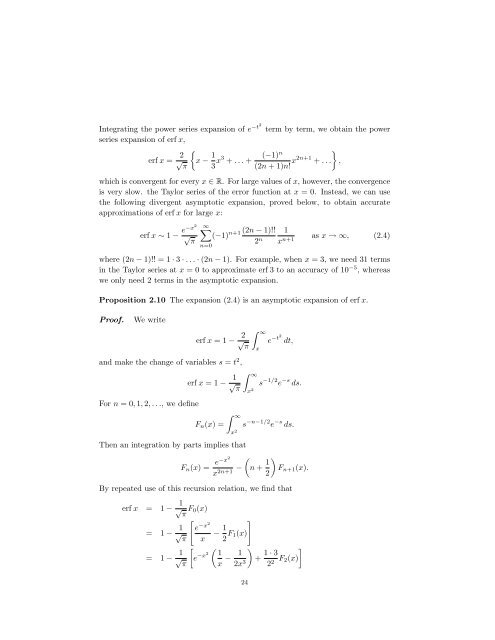Asymptotic Analysis and Singular Perturbation Theory
Asymptotic Analysis and Singular Perturbation Theory
Asymptotic Analysis and Singular Perturbation Theory
You also want an ePaper? Increase the reach of your titles
YUMPU automatically turns print PDFs into web optimized ePapers that Google loves.
Integrating the power series expansion of e−t2 term by term, we obtain the power<br />
series expansion of erf x,<br />
erf x = 2<br />
<br />
√ x −<br />
π<br />
1<br />
3 x3 + . . . + (−1)n<br />
(2n + 1)n! x2n+1 <br />
+ . . . ,<br />
which is convergent for every x ∈ R. For large values of x, however, the convergence<br />
is very slow. the Taylor series of the error function at x = 0. Instead, we can use<br />
the following divergent asymptotic expansion, proved below, to obtain accurate<br />
approximations of erf x for large x:<br />
erf x ∼ 1 − e−x2<br />
√ π<br />
∞<br />
n+1 (2n − 1)!!<br />
(−1)<br />
2n 1<br />
xn+1 as x → ∞, (2.4)<br />
n=0<br />
where (2n − 1)!! = 1 · 3 · . . . · (2n − 1). For example, when x = 3, we need 31 terms<br />
in the Taylor series at x = 0 to approximate erf 3 to an accuracy of 10 −5 , whereas<br />
we only need 2 terms in the asymptotic expansion.<br />
Proposition 2.10 The expansion (2.4) is an asymptotic expansion of erf x.<br />
Proof. We write<br />
erf x = 1 − 2<br />
√ π<br />
<strong>and</strong> make the change of variables s = t 2 ,<br />
For n = 0, 1, 2, . . ., we define<br />
erf x = 1 − 1<br />
√ π<br />
Fn(x) =<br />
∞<br />
x<br />
e −t2<br />
dt,<br />
∞<br />
x2 s −1/2 e −s ds.<br />
∞<br />
x2 s −n−1/2 e −s ds.<br />
Then an integration by parts implies that<br />
Fn(x) = e−x2<br />
<br />
− n +<br />
x2n+1 1<br />
<br />
Fn+1(x).<br />
2<br />
By repeated use of this recursion relation, we find that<br />
erf x = 1 − 1<br />
√ F0(x)<br />
π<br />
= 1 − 1<br />
<br />
e<br />
√<br />
π<br />
−x2 1<br />
−<br />
x 2 F1(x)<br />
<br />
= 1 − 1<br />
<br />
√ e<br />
π<br />
−x2<br />
<br />
1 1<br />
−<br />
x 2x3 <br />
+ 1 · 3<br />
<br />
F2(x)<br />
22 24
















